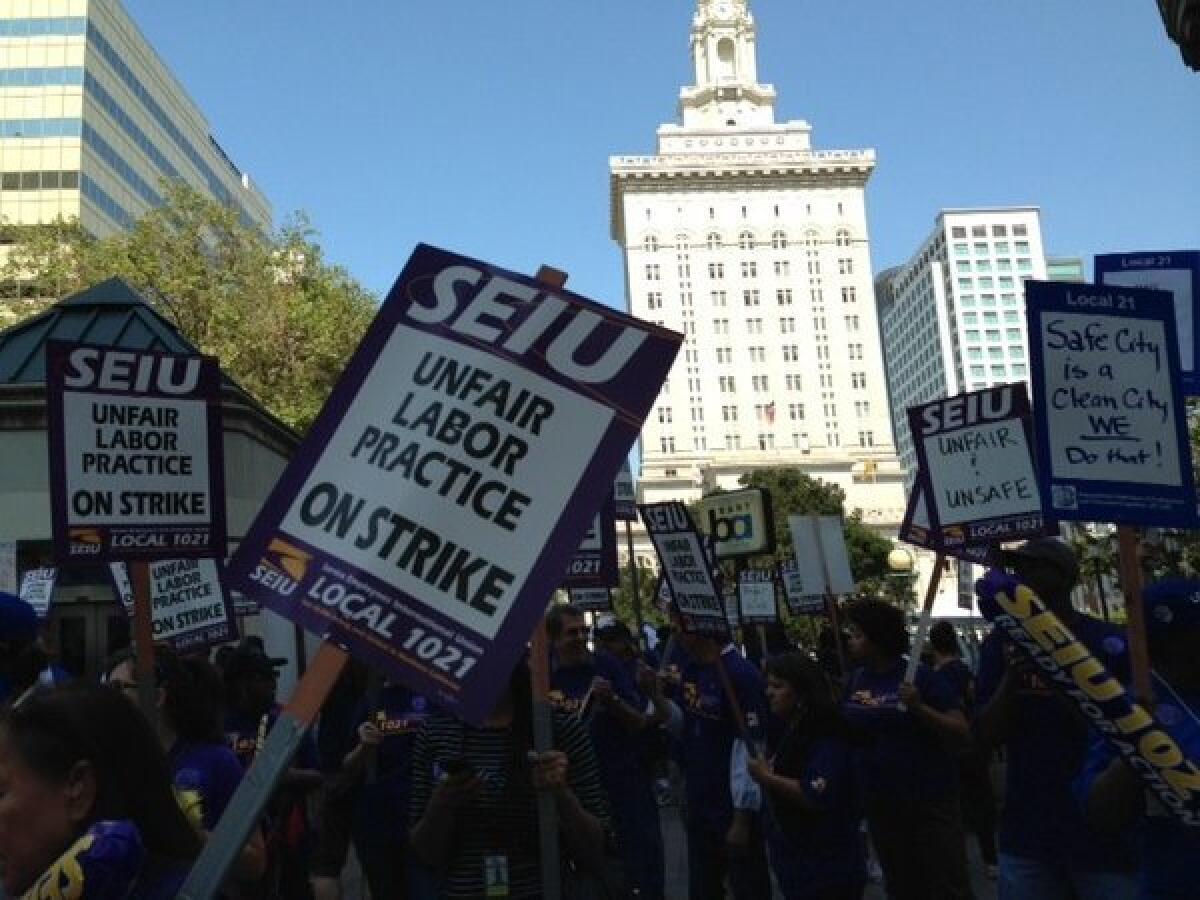Transit official on BART strike: ‘It could have been much worse’

- Share via
As striking Bay Area Rapid Transit workers placed the region’s commuters in a stranglehold Monday, they were joined by more than 3,000 Oakland city employees whose contract negotiations have also stalled.
The workers -- who do not include police, fire or other emergency personnel -- are represented by two unions and have been negotiating with city officials for the last 15 weeks. Like the BART workers, their contracts expired at midnight Sunday.
As temperatures approached 80 degrees by mid-morning, hundreds of workers in brightly colored union shirts rallied in front of Oakland City Hall, then moved onto the street to block traffic. The festive gathering -- workers tooted on high-powered kazoos and chanted -- evoked plenty of honks of solidarity.
The workers share a similar gripe: After years of give-backs in a down economy -- including furloughs, no cost of living increases and other sacrifices -- they want to benefit from the economic turnaround.
“Our members have lost 27% of their purchasing power over the past five years,” said Jeff Levin, spokesman for International Federation of Professional and Technical Engineers Local 21, which joined SEIU Local 21 in the one-day strike action. “When the city was in trouble our folks stepped up, but the economy’s coming back and there’s more money in the budget.”
Oakland Mayor Jean Quan met with the union representatives on Friday and along with city negotiators presented an economic package that included a cost-of-living pay increase for employees, “within the amount allocated in the budget” passed last week by the City Council, said city spokeswoman Karen Boyd.
Quan offered to meet Friday night and through the weekend to avert a strike, but the offers were declined. City negotiators are expected to meet with IFPTE Local 21 at its next regularly scheduled meeting Friday while SEIU Local 1021 negotiators have offered to meet on July 9.
Union officials, however, have accused the city of not bargaining in good faith, filing four “unfair labor practice” charges with the Public Employment Relations Board contending in part that the city has “engaged in surface bargaining,” failed to provide information crucial to bargaining and interfered with union activities.
Levin said the unions believe the city is “not being honest” with its budget figures. In a statement, Pete Castelli, lead negotiator of the Oakland contract and executive director of SEIU 1021, echoed the sentiment.
“We have sat through endless meetings of surface bargaining, where they don’t answer any of our questions,” he said. “City administrators have given us no financial reasons for their concessionary demands. At the bargaining table, there doesn’t appear to be anyone with any authority to make any real decisions.”
City workers have not gone on strike in Oakland since 1946. The full-and part-time workers include street and parks maintenance employees, librarian assistants and housing inspectors among others.
The city strike shuttered Head Start programs and senior centers, along with a free lunch initiative for Oakland youth, but its effect was overshadowed by the BART labor action. For all the headaches commuters faced, however, it could have been much worse.
Instead of going out on strike itself after its bus operators’ and mechanics’ contract expired, the Alameda-Contra Costa Transit District added more buses to help carry Bay Area commuters to work.
AC Transit spokesman Clarence Johnson said the agency had yet to tally the morning’s ridership, but it appeared to be “at least twice as much as normal” in some locations.”
Johnson said that although the contract with workers expired at midnight, the union “agreed to continue talking” and were huddled Monday. Though he “wouldn’t dare” say a Tuesday strike was not possible, Johnson said, “There has been some progress reported so that’s an encouraging sign.”
San Francisco Bay Ferry increased to 11 vessels from its usual eight and added runs Monday. The ferry agency “increased its carrying capacity to 50,000 seats compared to a normal 20,000 seats,” said spokesman Ernest Sanchez, and many of its boats were at capacity.
San Mateo County Transit added shuttles, and the number of casual carpoolers who offered rides to strangers heading to work also soared. In fact, there were more cars offering rides in many places than there were people who wanted a lift.
BART also got its hands on 58 buses that were offering free round-trip chartered rides to an estimated 2,000 to 4,000 passengers each way, depending upon traffic. Those buses left Monday morning from stations in El Cerrito, Walnut Creek, Dublin/Pleasanton and Fremont and a spokesman said they ran “smoothly.”
“Yesterday at this time, we were operating under the assumption that we would not have BART, and we would not have AC Transit,” said John Goodwin, spokesman for the Metropolitan Transportation Commission. “This is a tough day, but it could have been much worse.”
For all of the adjustments and additions, Goodwin said, there is no way that they can even begin to make up for the 400,000 trips taken on BART each weekday.
“Extra buses and ferries together might contribute at most one quarter of the lost capacity that we had with BART,” Goodwin said. “Where will the rest of that capacity come from? Empty seats in peoples’ cars.… I’m not surprised there was a supply-demand imbalance at casual carpool locations. I am surprised, though, that there was more supply than demand.”
ALSO:
BART official: ‘No talks are scheduled’ to end strike
BART strike: Union workers take to picket lines for ‘safety’
BART strike: Commuters find creative ways to get to work
More to Read
Sign up for Essential California
The most important California stories and recommendations in your inbox every morning.
You may occasionally receive promotional content from the Los Angeles Times.












